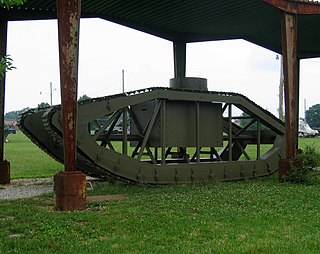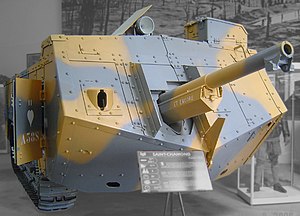
The history of the tank includes all vehicles intended to advance under enemy fire while remaining protected.

The Schneider CA 1 was the first French tank, developed during the First World War.

The Char 2C, also known as the FCM 2C, was a French post WWI heavy tank landship, later considered a super-heavy tank. It was developed during World War I but not deployed until after the war. It was, in total volume or physical dimensions, the largest operational tank ever made.
Jean Baptiste Eugène Estienne was a general of artillery and a specialist in military engineering, one of the founders of modern French artillery and French military aviation, and the creator of the French tank arm. He is considered by many in France to be the Père des Chars.

The Char B1 was a French heavy tank manufactured before World War II.

The Skeleton tank also known as the Spider tank was an experimental prototype tank built in 1918 by the Pioneer Tractor Company, Winona, Minnesota for $15,000. The prototype was ready for trials by October 1918. Designed with several innovative features, some of which were controversial at the time, the Skeleton Tank project did not proceed beyond the single prototype.

The Canon de 75 modèle 1915 Saint-Chamond also known as the Canon de Tir Rapide 75 mm St Chamond or the Saint-Chamond-Mondragón was specified in the 1890s by Mexican General Manuel Mondragón, designed mostly by Colonel Émile Rimailho, and produced by the French arms manufacturer Saint-Chamond. It was widely used by different forces during the Mexican Revolution. It was also used in modified form to arm some of the French Saint-Chamond tanks deployed during the First World War.

The Canon de 194 GPF - was the first French tracked self-propelled gun (SPG). Designed at the end of World War I, it was a pioneering weapon with many modern features.

The Frot-Laffly armoured roller, also Frot-Turmel-Laffly armoured roller, was an early French experimental armoured fighting vehicle designed and built from December 1914 to March 1915.

The Boirault machine, was an early French experimental landship, designed in 1914 and built in early 1915. It has been considered as "another interesting ancestor of the tank", and described as a "rhomboid-shaped skeleton tank without armour, with single overhead track". Ultimately, the machine was deemed impractical and was nicknamed Diplodocus militaris, after a Sauropod from the Jurassic. It preceded the design and development of the English Little Willie tank by six months.

The Levavasseur project was an early project for a tank designed in 1903 by the French Captain Léon René Levavasseur (1860-1942) of the 6th Artillery Battalion, described as a "self propelled cannon project". It is considered as the first description, made by a soldier, of what would come to be known as the tank. Levavasseur was a graduate of Ecole Polytechnique, of the promotion of 1881. According to Armoured Fighting Vehicles of the World:
A project for a vehicle which had all the characteristics later thought desirable in a tank was put forward to the French War Ministry as early as 1903. Devised by a Captain Levavasseur of the 6th Artillery Battalion, who called it a "canon autopropulseur", the vehicle was envisaged as carrying a 75mm gun mounted in a box-like steel caisson which ran on crawler tracks, or "roues articulées" as Levavasseur called them. Powered by an 80hp petrol engine, the Levavasseur machine would have had a crew of three, storage for ammunition, and a cross-country ability.

The Canon de 155 C modèle 1915 Saint-Chamond was a French howitzer used during World War I. It was based on a private prototype of a 150 millimetres (5.9 in) howitzer presented to the Mexican government in 1911. The French government ordered 400 Saint-Chamond howitzers in 1915, these being delivered starting in late 1916. Small numbers of Saint-Chamond howitzers were given to the Serbian and Romanian armies towards the end of World War I. The Saint-Chamond howitzer served in the French Army after World War I and were mobilised at the outbreak of World War II. Finland bought 24 Saint-Chamond howitzers during the Winter War and these served until the 1960s. The German Army captured some Saint-Chamond howitzers after the fall of France and used these mostly as coastal defence guns until the end of World War II.

The Breton-Prétot machine was an experimental wire-cutting device developed in France from November 1914. It was developed by Mr. Prétot, engineer, and Jules-Louis Breton, member of the French National Assembly.

The Souain experiment was a French military experiment using a Baby Holt Caterpillar, on the former battlefield of Souain, in northeastern France, on 9 December 1915. The experiment was a decisive influence on the French tank programme and initiated the design and order of the two French operational tanks, the Saint-Chamond and Schneider CA1.

The 75 mm gun M1916 was a US Army field artillery piece used during and after World War I. It was used as an anti-aircraft gun as well as a field piece. It originated as the 3-inch gun M1913, which was soon modified to the 3-inch gun M1916, which was later altered to the subject weapon.

Schneider et Compagnie, also known as Schneider-Creusot for its birthplace in the french town of Le Creusot, was a historic French iron and steel-mill company which became a major arms manufacturer. In the 1960s, it was taken over by the Belgian Empain group and merged with it in 1969 to form Empain-Schneider, which in 1980 was renamed Schneider SA and in 1999, after much restructuring, Schneider Electric.

French development into tanks began during World War I as an effort to overcome the stalemate of trench warfare, and largely at the initiative of the manufacturers. The Schneider CA1 was the first tank produced by France, and 400 units were built. The French also experimented with various tank designs, such as the Frot-Laffly landship, Boirault machine and Souain experiment. Another 400 Saint-Chamond tanks were manufactured from April 1917 to July 1918 but they were underpowered and were of limited utility because the caterpillar tracks were too short for the tank's length and weight. The most significant French tank development during the war was the Renault FT light tank, which set the general layout for future tank designs and was used or redesigned by various military forces, including those of the United States.

The Mortier 280 mm TR de Schneider sur affût-chenilles St Chamond was a French self-propelled siege howitzer designed during the First World War and used during the Second World War.






















